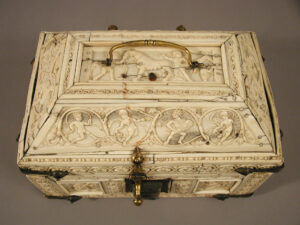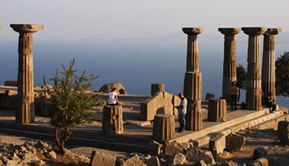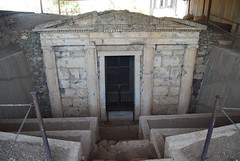Dancing in the streets, Byzantine-style
From its place in celebrations of military triumph, to spontaneous outpourings of joy, dancing was surprisingly popular in Byzantine society, says Leslie Brubaker

Erotes dance in almost Dionysiac delight on an 11th-century ivory casket from Constantinople (The Metropolitan Museum, New York (public domain), gift of J. Pierpont Morgan, 1917)
The eleventh-century polymath Michael Psellos, one of the most famous of all Byzantine historians, greatly admired the writings of the fourth-century church father Gregory of Nazianzos. Psellos was particularly attracted to Gregory’s rhythmic writing style. Gregory’s sermons were regularly read out in church services, and Psellos writes of a congregation so enraptured by listening to the reading of one of them that they first murmured among themselves, then cheered along with the rhythmic cadences, until finally some of them began to dance to the rhythm of Gregory’s words.
Dancing in the aisles is not an activity that many of us associate with the Byzantines, who are usually presented as rather a staid and humourless bunch of people who spent a lot of time praying. But, in fact, there are lots of references to Byzantines – men and women – dancing in public, both in churches and, more often, in the streets of their capital city, Constantinople (now Istanbul).
From the very earliest days of the East Roman Empire, dancing was associated with triumphs. We hear – from no less an authority than the bishop of the city, John Chrysostom (c. 400) – of the citizens of Antioch dancing in the street in celebration of a military victory. From the same period, we have textiles that depict warriors dancing, also to rejoice in their triumph. And from the earliest accounts of events in the hippodrome of Constantinople, we hear of winning charioteers dancing in their chariots as they made their victory lap (which must have been rather precarious) and then asking the emperor for permission to continue their dancing in the streets of the city.
Dancers also entertained the crowd between races, as shown on the obelisk base (c. 400) still in place at the site of the former hippodrome of Constantinople, which marked the turning point of the chariots as they raced. The latest record of charioteers dancing in victory and then on into the streets appears in the mid-tenth-century Book of Ceremonies, a compilation of imperial protocols made at the request of the emperor Constantine VII Porphyrogennetos (ruled 913–59). But long after that (for example, on a circular ivory box now at Dumbarton Oaks in Washington DC that dates to the thirteenth or fourteenth century), we continue to have images of dancers and musicians greeting triumphant returning rulers.
Dancing was not only associated with victory celebrations. Sometimes, it appears to have been a spontaneous expression of joy in response to rhythmic declamations, as with Psellos’ dancers in the aisle with which we began. An earlier, and particularly eloquent, description of this appeared in Corippus’ In praise of Justin II, written in Constantinople in 565: ‘When all was quiet the happy people decorated the holy walls throughout the city by garlanding the buildings….They decorated the doorposts and adorned the thresholds with reeds, and stretched festive covering in all the streets. Then the young men began to make merry and add praises to praises; they applauded with their feet, and stepped out in sweet steps and made new songs with wonderful tunes.’
Dancing was also criticised by churchmen, who associated it with un-Christian behaviour. Chrysostom (among others) complained about women dancing at funerals, which he saw as a pagan hold-over. The fifth-century historian Socrates tells us that bishop Cyril drove the Jews out of Alexandria in the 420s because they were promoting ‘an evil that has become very popular in almost all cities, a fondness for dancing exhibitions’. Canon 62 of the Council in Trullo (691/2) famously forbade public exhibitions of dancing: ‘we abolish public dances by women, which may cause great harm and mischief, and also the dances and rites performed either by men or women in the name of those whom the pagans falsely called gods’. The distinction is gendered: under no circumstances should women move rhythmically in public, while for men (and also women, but this is a secondary consideration) the major objection was involvement in pre-Christian rituals.
These condemnations were never successful, and, as Nicoletta Isar has observed, churchmen who routinely condemned inappropriate dancing also regularly invoked the celestial dance of angels around the lord. To Byzantine churchmen, dancing could be either appropriate or inappropriate, depending on the context in which it was performed.
In a sermon written around 400, for example, Chrysostom (who talks a lot about dancing) wrote, ‘Where there is dance there is the devil,’ but, later in the same sermon, noted that ‘God gave us feet … not so that we could disfigure out bodies, not so that we could prance like camels … but so that we might dance with angels.’ In any event, dancing persisted.
From the ninth century until the end of the empire in 1453, dancing is mentioned in texts (though never in detail, which suggests that it was a commonplace activity that required no description) and depicted in images. In both media, dancing could be a self-contained event or part of a procession or parade down the streets. The dancing women portrayed on the base of the obelisk in the hippodrome seem to be providing localised entertainment rather than forming part of a parade, and the dancing women on the eleventh-century enamels that form part of the so-called crown of Constantine Monomachos provide a later parallel to dancing as entertainment divorced from any obvious processional setting.
In contrast, the late antique textiles mentioned earlier and a sequence of images from the ninth century onwards clearly depict dancing as part of processions, usually, as with the dancers on the obelisk base, associated with triumphs or victory celebrations. Dancing as part of a procession appears in two contexts: representations of David’s entry into Jerusalem after the defeat of Goliath (this is what the triumphal imperial entry into a city on the late Byzantine ivory at Dumbarton Oaks, mentioned earlier, is based on), and miniatures of the Crossing of the Red Sea with the dance of Miriam.
The miniatures nearly all illustrate books of psalms, which were some of the most widely produced texts of the Byzantine world; David’s psalms were part of the daily liturgy in all orthodox churches and children learned to read using the psalter as their key textbook. The images of David’s entry into Jerusalem show him greeted by a parade of musicians and dancing women. The miniatures of Miriam dancing usually show Miriam whirling about, arms raised, at the head of a procession of Israelites who have just crossed the Red Sea, while the drowning Egyptians appear in the background. This illustrates one of the Odes attached to the psalter, an extract from Exodus 15:20-21, ‘And Miriam the prophetess, the sister of Aaron, having taken a timbrel (tympanon) in her hand – then there went forth all of the women after her with timbrels and dances. And Miriam led them, saying, Let us sing to the lord, for he has been greatly glorified: the horse and rider has he cast into the sea’.
Occasionally, as in a miniature in an eleventh-century psalter now in the Vatican (BAV gr.752, f.449v) we see this text more fully illustrated, with all the women of Israel dancing in a circle, holding each other’s wrists. This recalls ancient images of Dionysiac dances as depicted on Greek vases, and, as Mati Meyer has shown, was probably originally inspired by something similar.
It is tempting – though speculative – to see this as a visual parallel, outside the victory context, to another text by the eleventh-century author Michael Psellos, roughly contemporary with the Vatican miniature. Psellos described women dancing as part of what appears to have been an annual guild celebration organised by female textile workers on 12 May. He wrote that the procession was followed by a ritual involving images of women carding linen and weaving, and, finally, a dance in which the women held each other by the wrist, as they do in the psalter miniature, and turned from side to side, rather like circle dances today. What is notable about Psellos’s description is that it once again pairs processions and dancing with women. The Agathe festival, as this was known, occurred the day after the birthday celebration in Constantinople on 11 May that also involved dancing in the street; it was presumably seen as a continuation of the festivities by a specialised group of (female) workers. This is an important indication that there was more female participation in Byzantine public life than one would suppose from most ecclesiastical texts, and suggests that church laws forbidding women to dance in public contexts were responses to realities rather than just examples of gendered, broadly anti-female, rhetoric.
We may conclude that there was dancing in the streets of Constantinople, and that this frequently occurred as part of processional activities organised by the charioteers and by the guilds. Performance may also have been spontaneous at times, as suggested by the sixth-century text by Corippus (and possibly the eleventh-century passage by Psellos with which we opened), but this is not something we hear about with any regularity.
This conclusion is significant for several reasons. Perhaps most notably, it has simply never before been noticed that dancing was a regular and unremarkable part of social performance in the Byzantine capital. We are so accustomed to thinking of the Byzantines as acting within formal and hierarchical straightjackets that it comes as a considerable surprise to realise that this was not always the case. Equally startling, from the standpoint of the traditional view of Byzantine society, is the role of women, and the accepted public participation of ‘respectable’ women in both processions and processional dancing. In the Middle and Late Byzantine periods, images of dancing, in fact, almost invariably show women, not men, though men are sometimes (though not always) responsible for the music to which the women dance.









